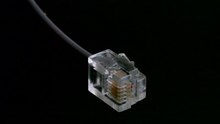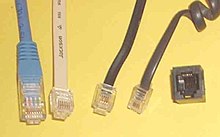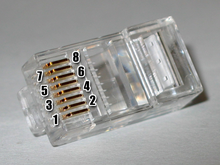RJ connector
RJ plug connections are standardized plug connections for telecommunications cabling in the US Code of Federal Regulations (CFR) Part 68. The standards describe the designs of plugs and sockets as well as their contact assignments and are designated with the letters RJ in connection with a number (e.g. RJ-45 ) - sometimes without a hyphen (RJ45) - with the letters "RJ" for Registered Jack ('standardized socket').
Most RJ plug connections are based on modular plugs and modular jacks , but must not be equated with these. There are also RJ connectors, such as the RJ-21, which are based on completely different connector designs. RJ connectors are used worldwide for telephone and network connections today. Customarily, cables come with twisted wires ( twisted pair ) are used.
designation
The RJ plug connections were introduced by Bell Laboratories in the USA in the 1970s and standardized a few years later by the Federal Communications Commission (FCC). Many American telephone and telecommunications companies, such as Western Electric , have made extensive use of some of the RJ connectors, particularly modular plugs on telephone plugs . This resulted in the widespread use of these plug types, from which the slang terms such as "Western modular plug" and, for simplicity, "Western plug" or socket are derived.
The plugs and sockets are available in different designs, shapes and with different numbers of contacts. For categorization, the names follow a scheme: The name begins with the letter sequence RJ , followed by two digits that specify the specific connector type. This can be followed by a "suffix", sometimes written in brackets, which describes certain additional, mostly mechanical, properties:
- C: Flush connector
- W: wall socket (or socket)
- S: single connection
- M: multiple connector
- X: Complex connector
This can be followed by a designation which specifies the number of possible contact positions ( P , for "Positions") and the number of contacts actually fitted ("C" for "Contacts"). For example, a plug can have six possible contact positions, but only four of them are actually equipped with contacts. Such a connector is called "6P4C".
Some of the RJ connectors and contact splits that are common in the North American telecommunications and telephony sectors are:
- RJ-2MB: 50-pin miniature plug for two to twelve telephone lines
- RJ-11C / RJ-11W: 6P2C, for telephone connection lines (or 6P4C with power supply via the second pair)
- RJ-12C / RJ-12W: 6P6C, for a telephone line and additional control lines (is also used for Mindstorms NXT and in the Microchip environment.)
- RJ-13C / RJ-13W: 6P4C, for a telephone line and additional control lines
- RJ-14C / RJ-14W: 6P4C, for two telephone connection lines (or 6P6C with power supply via the third pair)
- RJ-15C: three-pin, waterproof connector for a telephone line
- RJ-18C / RJ-18W: 6P6C, for a telephone line with "make-busy arrangement"
- RJ-21X: 50-pin miniature connector for 25 telephone lines
- RJ-25C / RJ-25W: 6P6C, for three telephone lines
- RJ-26X: 50-pin miniature connector for multiple data lines
- RJ-27X: 50-pin miniature connector for multiple data lines, configurable
- RJ-31X: 8P8C or 8P4C, telephone plug
- RJ-38X: 8P8C, similar to RJ-31X, with the option of line interruption
- RJ-41S: 8P8C, coded connector system, for one data line, with universal use
- RJ-45S: 8P8C, for one data line, with electrical resistance for secure coding
- RJ-48S: 8P8C, for up to four data lines (DDS)
- RJ-48C: 8P8C, four data lines (DSX-1)
- RJ-48X: 8P8C, like RJ-48C, with short-circuit device (DS1)
- RJ-49C: 8P8C, for ISDN connections, data networks
- RJ-61X: 8P8C, four telephone lines, partly ISDN and data networks
- RJ-71C: 50-pin plug with bridging option, for up to twelve telephone connections in series, primarily used in telephone systems
Several other RJ designations have partly established themselves in the designation scheme, but are not part of the standard and therefore, strictly speaking, do not represent RJ connectors:
- "RJ-45": 8P8C-occupancy of twisted pairs (sometimes just 8P4C), in particular for twisted pair Ethernet or ISDN S 0 used
- "RJ-9", "RJ-10", "RJ-22": 4P4C or 4P2C: primarily used with telephone receivers
- "RJ-50": 10P10C, mostly used in data networks
Common modular plugs
The best known RJ plug connections used in the PC / network area and telephony area are modular plugs. Common types are equipped with six contact positions, of which two (6P2C) for RJ-11, four (6P4C) for RJ-14 (and the rarely used RJ-13) and all six positions (6P6C) for RJ-25 are.
In the network area, every fully equipped eight-pin (8P8C) modular connector is often called an “RJ-45”. The name GG-45 , derived from this, represents, like TERA, a variant for use in data communication systems of category 7. In Germany, unshielded, fully equipped eight-pin (8P8C) modular plugs are colloquially known as ISDN plugs, and shielded plugs as " Ethernet plugs".
Outside the circle of US telecommunications specialists, there is often confusion and inaccuracies in the assignment of RJ identifiers to the smaller of the above-mentioned plugs. The six-pole sockets and plugs used for telephone connections can be wired for RJ-11 as well as for RJ-12, RJ-13, RJ-14 or RJ-25 as well as for some other cabling variants, whereby a "plug face" is defined in each case based on six contact positions (Poland). With RJ-11 only the innermost contact pair is used, with RJ-14 and the rare cabling variants RJ-12 and RJ-13 four contacts each and with RJ-25 all six contacts. The even smaller four-pole plug, with which, for example, the telephone receiver is connected to the base unit, does not appear in any RJ standard. It is often referred to as RJ-10, RJ-9, or RJ-22 because it is smaller than the six-pin variant.
Allocation of RJ wiring variants to modular connector designs common in Europe
| RJ variant | Contact positions |
contacts | Plug / socket name |
Contact no. Plug from the front |
image | Connector width |
Application examples |
|---|---|---|---|---|---|---|---|
| No RJ standard, colloquially e.g. T. "RJ-10", "RJ-9" or "RJ-22" | 4th | 4th | 4P4C |

|

|
7.7 mm | On both sides for telephone receiver lines |
| RJ-11 | 6th | 2 | 6P2C |

|

|
9.6 mm | Connection of telephones , fax machines or modems with one line (in DA-CH only the end of the line on the device side, the other end is equipped with a TAE / TST / TT87 / 89 plug) |
| RJ-14 | 6th | 4th | 6P4C |

|

|
9.6 mm | Connection of telephones, fax machines or modems with two lines (in DA-CH only the end of the line on the device; the other end is equipped with a TAE / TST / TT87 / 89 connector) |
| RJ-12 (RJ-25) | 6th | 6th | 6P6C |

|

|
9.6 mm | Connection of fax machines, modems or multifunctional devices with three lines; 6P6C also with LocoNet . RJ-25 is the stranded (braided) variant of RJ-12. The plug is the same, only the cable is different. |
| Fully wired 8P8C without resistors; actually RJ-48, RJ-49, or RJ-61; Often referred to colloquially as "RJ-45" or "ISDN-RJ-45". | 8th | 8th | 8P8C |

|
 
|
11.6 mm | Connection sockets and cables for ISDN ( IAE ), U p0 , structured cabling and computer networks ( UAE , Ethernet , TIA-568A / B ) |
| No RJ standard; Modified Modular Plug / Jack (MMP / MMJ) or colloquially "DEC Type" (after the company DEC ) | 6th |

|
 Modular plug with offset locking lug |
9.6 mm | Device side, for example, in the NT , DSL splitter , but does not fit with Lego Mindstorms NXT , the nose is on the other side (in DA-CH only device-side end of the line, other side with TAE / TST / TT87 / 89 fitted plug) Will also used for power supply / power supply connections of DECT base stations etc. |
Assignment of modular connector designs to RJ numbers in German retail
In German retail, the following (actually incorrect) designations are used consistently for RJ plugs and sockets, suitable pliers and assembled cables: (... P ... C = ... positions ... contacts)
| Contact positions |
Trade name |
|---|---|
| 4P4C | RJ-10 |
| 6P2C | RJ-11 |
| 6P4C | RJ-11 or RJ-14 |
| 6P6C | RJ-12 (RJ-25) |
| 8P8C | RJ-45 |
| 10P10C | RJ-50 |
| 12P12C | ? |
| 15P15C | ? |
Contact assignment
The modular plugs were developed in such a way that a four-pole modular plug fits into a six- or eight-pole socket and connects there with the innermost four contacts, the six-pole plug fits into an eight-pole socket, where it connects to the central six contacts. This theoretical compatibility is sometimes undesirable from a manufacturer's point of view; It has also been found that it can result in end customers connecting the devices to the wrong sockets and, in extreme cases, destroying them. ISDN plugs (40 volts) connected to the network in Ethernet devices (0.75 volts) can also destroy the Ethernet devices.
The original concept was that the inner two contacts made a pair, the next outer another pair, and so on up to the two outermost contacts that made the fourth pair. In addition, the signal transmission has been optimized by changing the “active” contact and the contact connected to ground of each pair. With this contact assignment, however, the outermost wires in the eight-pin connector are so far apart that they no longer meet the electrical requirements for high-speed LAN protocols. For this reason, two assignment variants have been standardized under the designation TIA-568A / B , in which two adjacent contacts form the third or fourth pair.
If you look at the contact side of the plug and the contacts point upwards, they are counted from left to right. When numbering it should be noted that the pin positions ("P") are always counted, regardless of whether they are also occupied ("C"). So has z. B. a 6P4C connector does not have pin numbers 1 to 4, but 2, 3, 4 and 5, which corresponds to the pin positions.
Applications
Some of the assignments of eight-pole modular plugs are given below as examples:
| application | 1 | 2 | 3 | 4th | 5 | 6th | 7th | 8th |
|---|---|---|---|---|---|---|---|---|
| 10BASE-T, 100BASE-TX | Tx + | Tx- | Rx + | Rx- | ||||
| 10BASE-T, 100BASE-TX with PoE alternative B | Tx + | Tx- | Rx + | PoE 48V | PoE 48V | Rx- | PoE Gnd | PoE Gnd |
| Gigabit Ethernet (1000BASE-T), 100BASE-T4 according to TIA-568A / B | D1 + | D1- | D2 + | D3 + | D3- | D2- | D4 + | D4- |
| ATM TP-PMD |
1a | 1b | 2a | 2 B | ||||
| Token ring | 2a | 1a | 1b | 2 B | ||||
| U P0 (U K0 ), U 200 , U 2B1Q , U * | 2a 1 | 1a | 1b | 2b 1 | ||||
| Analog telephone, newer assignment (international) | a2 | W 2 | a | b | E 2 | b2 | ||
| Analog telephone, older occupancy (Germany) | a2 | a | E. | W. | b | b2 | ||
| ISDN S 0 bus | 2a | 1a | 1b | 2 B | ||||
| ISDN S 2M (E1) on the network termination ISDN S 2M (E1) on the terminal |
TX (NT) RX (TE) |
TX (NT) RX (TE) |
RX (NT) TX (TE) |
RX (NT) TX (TE) |
||||
| DSL splitter | 1a | 1b | ||||||
| T + T connection (Switzerland): RJ11 only 1a, 1b / RJ14 with 2a, 2b | 1a | 1b | (2a) | (2 B) | ||||
| 1-Wire Bus Dallas RJ 11/12 |
+ 5V DC (stabilized) | GND | 1-wire data | 1-Wire GND | nc | nc | ||
|
1-Wire Bus IPS RJ45 |
+ 5V GND | + 5V DC | Secondary 1-Wire GND |
1-wire data |
1-Wire GND |
Secondary 1-wire data |
+ 12V DC | + 12V GND |
| IGC -compliant logger assignment 3 | GND | GND | Rx 4 | Tx 4 | kept free | kept free | + 12V DC | + 12V DC |
|
1 Optional for external power supply |
||||||||
Individual evidence
- ↑ Title 47 CFR Part 68 . Retrieved December 1, 2016.
- ↑ Code of Federal Regulations 47 CFR 68, subpart F. In Part 68 of Title 47 there is only the empty subpart “F” with the note “Reserved”. .
- ↑ The electronics compendium: Western modular plugs .
- ↑ RJ Jack Glossary RJ jacks from RJ11 to RJ48
- ↑ RJ48C and RJ48S RJ48X
- ↑ Federal Communications Commission § 68.500, pp.385f. photos
- ↑ A Guide to the 1WRJ45 Standard Draft ( ZIP ; 385 kB).



